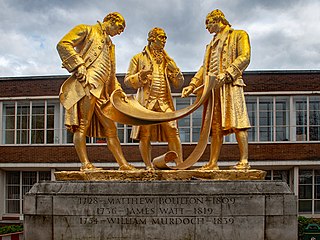 W
WJames Watt was a Scottish inventor, mechanical engineer, and chemist who improved on Thomas Newcomen's 1712 Newcomen steam engine with his Watt steam engine in 1776, which was fundamental to the changes brought by the Industrial Revolution in both his native Great Britain and the rest of the world.
 W
WBoulton & Watt was an early British engineering and manufacturing firm in the business of designing and making marine and stationary steam engines. Founded in the English West Midlands around Birmingham in 1775 as a partnership between the English manufacturer Matthew Boulton and the Scottish engineer James Watt, the firm had a major role in the Industrial Revolution and grew to be a major producer of steam engines in the 19th century.
 W
WThe James Watt College was a further education college in Greenock, Scotland. It is now part of West College Scotland. There were also campuses in Largs and Kilwinning which now form part of Ayrshire College as the result of the merger with Kilmarnock College and Ayr College.
 W
WIn mathematics, Watt's curve is a tricircular plane algebraic curve of degree six. It is generated by two circles of radius b with centers distance 2a apart (taken to be at. A line segment of length 2c attaches to a point on each of the circles, and the midpoint of the line segment traces out the Watt curve as the circles rotate partially back and forth or completely around. It arose in connection with James Watt's pioneering work on the steam engine.
 W
WHeathfield Hall was a house in Handsworth, Staffordshire, England, built for the engineer James Watt.
 W
WHorsepower (hp) is a unit of measurement of power, or the rate at which work is done, usually in reference to the output of engines or motors. There are many different standards and types of horsepower. Two common definitions used today are the mechanical horsepower, which is about 745.7 watts, and the metric horsepower, which is approximately 735.5 watts.
 W
WOld Bess is an early beam engine built by the partnership of Boulton and Watt. The engine was constructed in 1777 and worked until 1848.
 W
WThe Lap Engine is a beam engine designed by James Watt, built by Boulton and Watt in 1788. It is now preserved at the Science Museum, London.
 W
WWatt's linkage is a type of mechanical linkage invented by James Watt in which the central moving point of the linkage is constrained to travel on a nearly straight line. It was described in Watt's patent specification of 1784 for the Watt steam engine.
 W
WOld Bess is an early beam engine built by the partnership of Boulton and Watt. The engine was constructed in 1777 and worked until 1848.
 W
WThe Smethwick Engine is a Watt steam engine made by Boulton and Watt, which was installed near Birmingham, England, and was brought into service in May 1779. Now at Thinktank, Birmingham Science Museum, it is the oldest working steam engine and the oldest working engine in the world.
 W
WThe Watt steam engine, alternatively known as the Boulton and Watt steam engine, was an early steam engine and was one of the driving forces of the Industrial Revolution. James Watt developed the design sporadically from 1763 to 1775 with support from Matthew Boulton. Watt's design saved so much more fuel compared with earlier designs that they were licensed based on the amount of fuel they would save. Watt never ceased developing the steam engine, introducing double-acting designs and various systems for taking off rotary power. Watt's design became synonymous with steam engines, and it was many years before significantly new designs began to replace the basic Watt design.
 W
WThe Whitbread Engine preserved in the Powerhouse Museum in Sydney, Australia, built in 1785, is one of the first rotative steam engines ever built, and is the oldest surviving. A rotative engine is a type of beam engine where the reciprocating motion of the beam is converted to rotary motion, producing a continuous power source suitable for driving machinery.